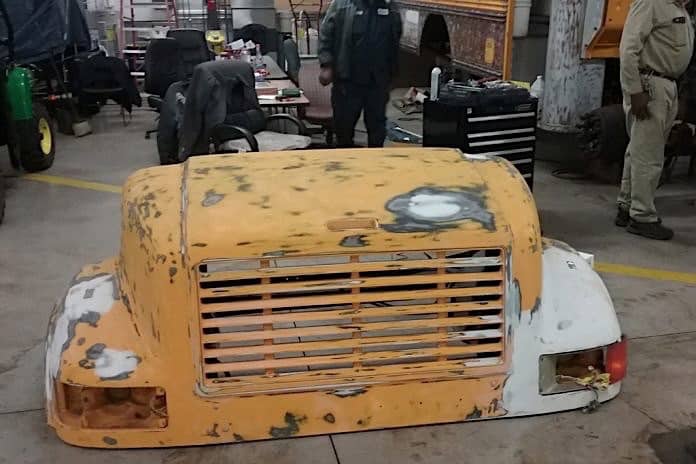Is funding or capital the factors school districts or bus companies should consider for determining how long a school bus should be used? Is this the single most important consideration in determining when school buses are replaced?
Does the advantage of getting all the latest operational and safety technology get lost in the funding challenge? Or is your transportation department reviewing the possibility of an extension to bus life through refurbishing bus components or retrofitting aftermarket technological improvements? How much can be gained by refurbishing or retrofitting when compared to replacement?
Whenever operating and maintenance expenses on a group of school buses, reach a certain level, would the better economic decision would be to purchase a new bus rather than continue to maintain the older school bus and possibly, refurbish the bus or simply retrofit
select technological improvements? This is the classical cost/benefit analysis:
Does the cost to refurbish the bus or retrofit the latest add-on technology make economic sense? And will the refurbish retrofit add to the life of the vehicle?
Related: There Are Many Ways to Skin a School Bus
The benefits of improved student safety, driver comfort, operating cost efficiency, environmental, and many integrated safety technological advancements should have an impact on your decisions concerning school bus replacement, retrofitting or refurbishing.
Replace
When a school bus isn’t bothering you, it’s easy to forget about the need that led to its acquisition. When it becomes unreliable, faded or rusted, your reaction may be to replace it. However, before you lay down money to replace or repair, go back to that original need and see if it still exists: You may find it has grown or shrunk.
Reassessing the purpose served, you may find that in the past the bus was overbuilt. The broken-down Type D school bus was simply too large, fast or feature-rich for how it was used. In this case, downgrading to a smaller capacity Type C will still meet the need and save you money in the process. Smaller capable models may also be less complex and therefore increase reliability. Bells and whistles are great, but they also expand the number of things that can go wrong with the bus as it ages.
The other possibility is that the bus in question was under serving your needs: This is the case for upgrading. Perhaps a new feature can save you a lot of labor, or the latest models use less energy and will therefore cost less to operate. This is all great, but the numbers need to be right. Make sure you calculate the return on investment to ensure the additional benefits will pay for themselves. When upgrading, what we’re really talking about is “spending money to save money.” This is exactly what entrepreneurs do.
Refurbish
This option means restoring existing equipment to its original condition and performance specification. This option is “age” driven, as there is often limited access to the original manufacturer’s materials and documentation. However, a refurbish can—in some instances—enhance the performance of equipment supplied and—in certain geographic areas where corrosion is not a factor—make a more meaningful business case to extend the operating life.
A refurbishment will involve a maintenance sweep of all parts chassis and body, (inspection, cleaning, and lubrication of parts, adjustments, and electrical component tests) with damaged parts refurbished or replaced. This process is the basis for a reliability-based maintenance program, or replace a worn part or component before it breaks.
The major advantage of this option is the overall cost savings. This is because the refurbishment cost of a bus may be cheaper than the equivalent of total replacement.
In most school bus maintenance realms, it is widely accepted that it is costlier to operate and maintain older school buses than newer school buses. However, the vehicle age at which the total operating costs of an older bus versus a newer bus becomes intolerable is not an exact science. Mileage and environment are variables that can influence the age at which a bus refurbishing plan will assure a return on the investment.
Retrofit
This involves replacement of the old school bus components within the existing chassis and body system with a new, modern component. Typically, a retrofit is carried out on an existing school bus that is of good condition and has a considerable time remaining until its end of life.
An example of retrofitting could be upgrading a 2007 diesel engine by replacing it with a 2010 or newer emission-rated diesel. This would be done for additional emissions improvement to the bus and to provide better economy. Care and consideration to the state and federal certification standards need to be taken when performing any retrofits to the existing engine.
Technology retrofits that enhance the safety aspects of student transportation vehicles are, for some, significant improvements. It is likely that a consensus of what constitutes “significant” could be achieved easily, like stop arms, crossing gates, cameras, electronic data recording, etc. For other items, it may be impossible to get everyone to agree on the importance of the improvement.
Straightforward technology retrofits offer minimal disruption to the bus. Using a “staged” retrofit for multiple components allows the user to have greater control of adaptability.
Conclusions
Establishing policies for school bus replacement, refurbishments and retrofits is an important activity, since it directly impacts the timeliness of introducing the latest safety, efficiency and emissions improvements into the fleet.
Retrofitting technology and refurbishing must be timed to occur during the life of the bus to take advantage of the investment. The replacement of school buses that do not meet efficient transportation needs, emission standards or reliability requirements should be planned for within a realistic number of years. Policy makers must realize that school buses will not last forever, regardless of how they are equipped when purchased or maintained during their lives.
EPA requirements with respect to fuel efficiency and vehicle tailpipe emissions, such as those that became effective on Jan. 1, 2010, have been expanded to include further reductions of tailpipe emissions through the perceived economic benefits of the federal greenhouse gas reduction acts, referred to as GHG Phase I (2018) and Phase II (2021). These efforts are likely to continue. Unless school bus replacement plans are developed to include the benefit of these technologies and are implemented, the new buses with improvements in safety, efficiency and cleaner air will not reach desired goals in a timely manner.

Editor’s Note: Robert T. Pudlewski has over four decades of experience in the school bus industry. He is the retired vice president of fleet operations, procurement and maintenance for Laidlaw.
















